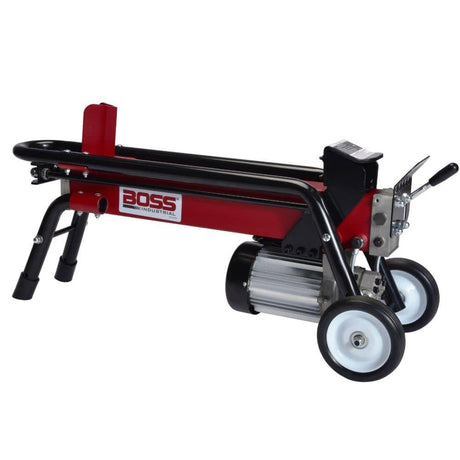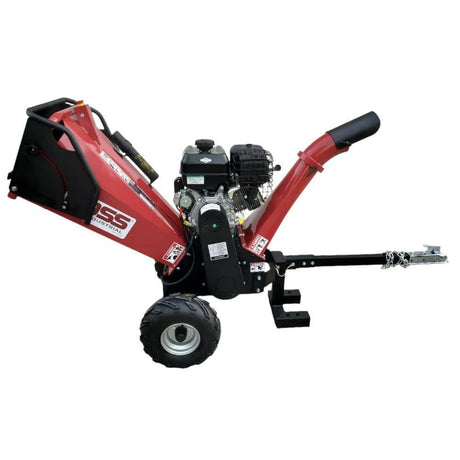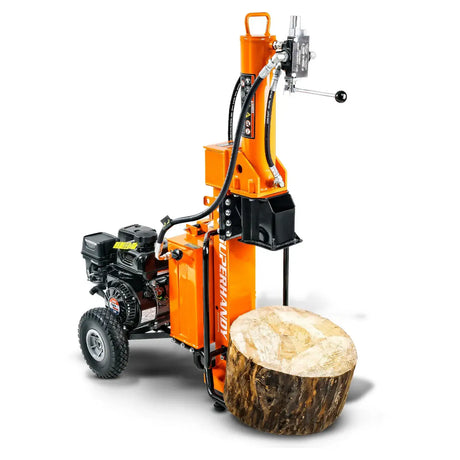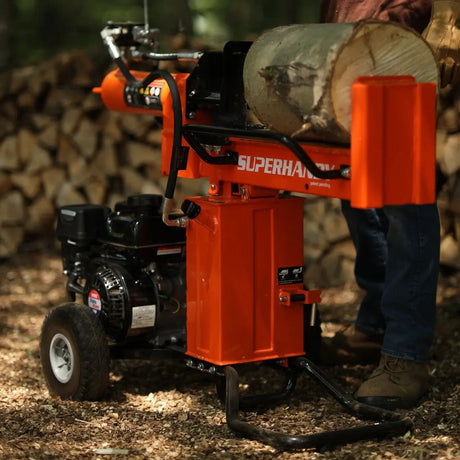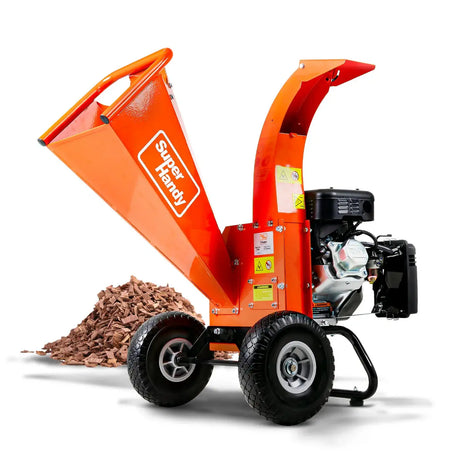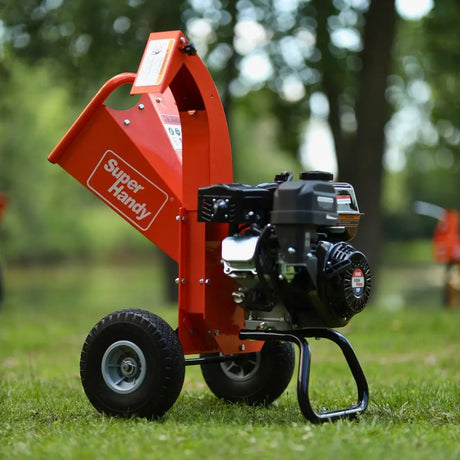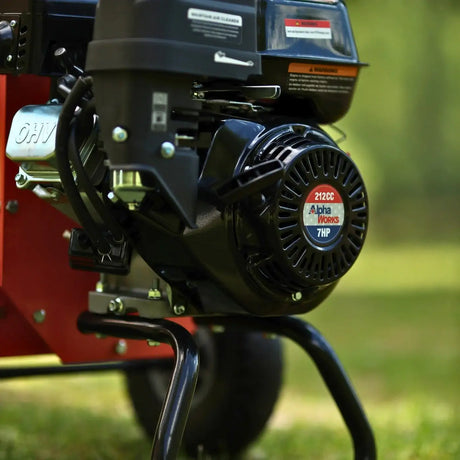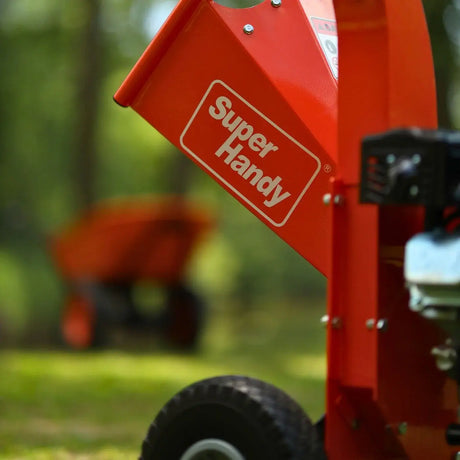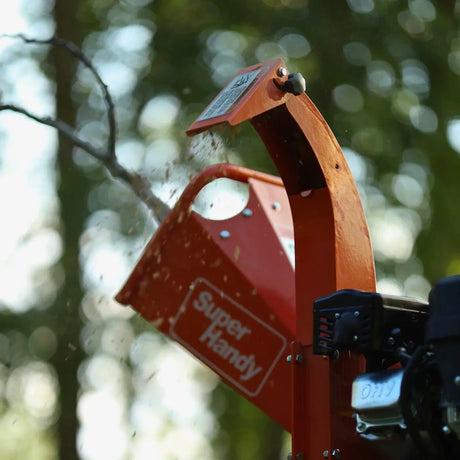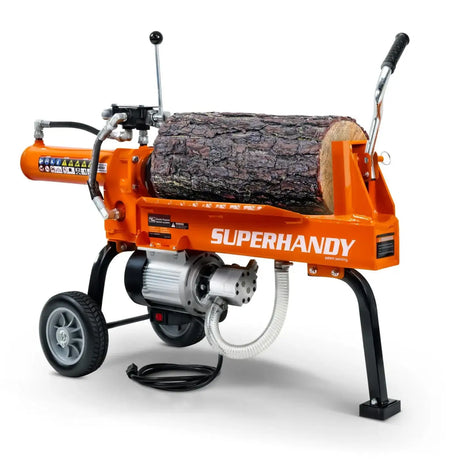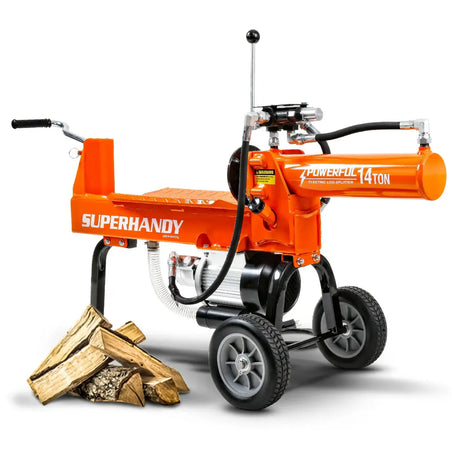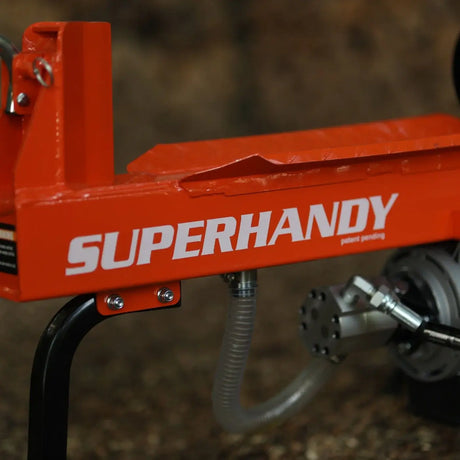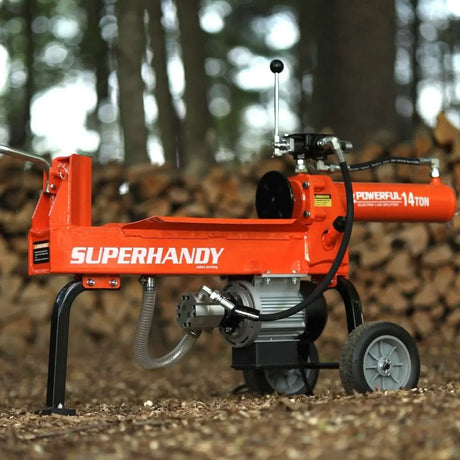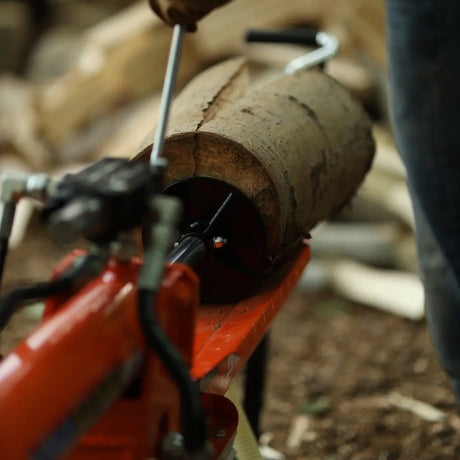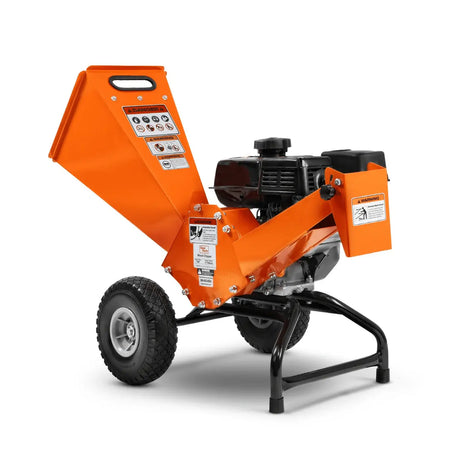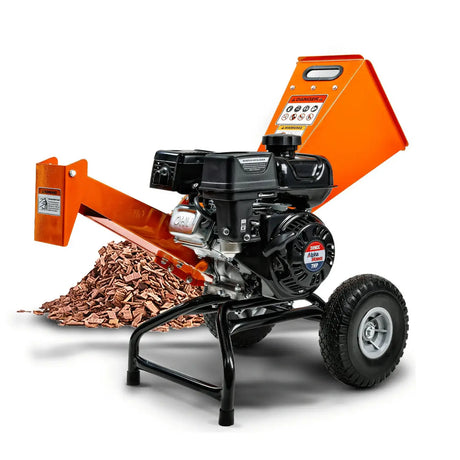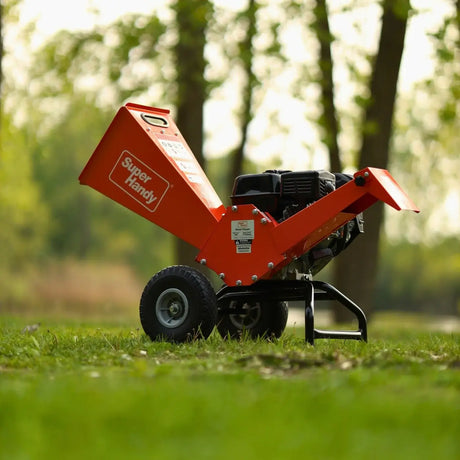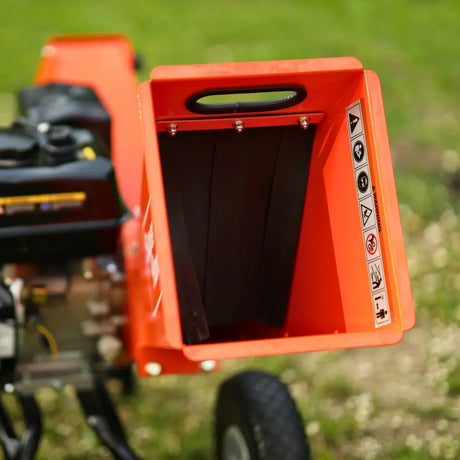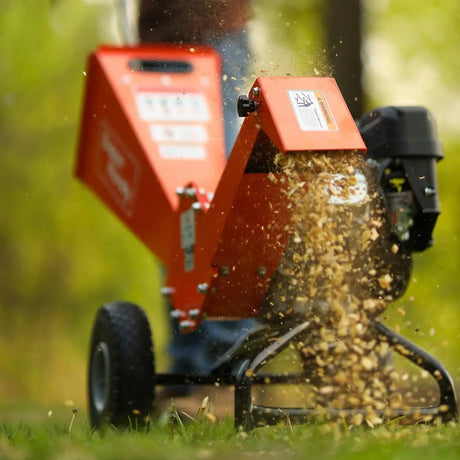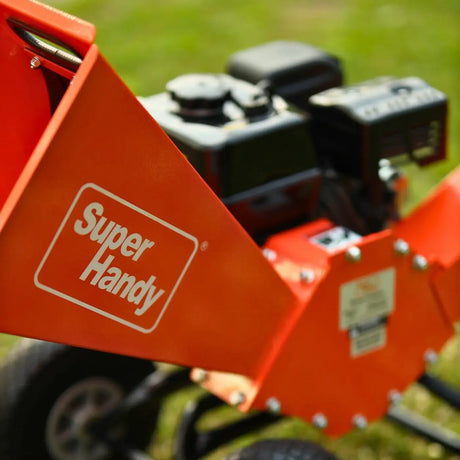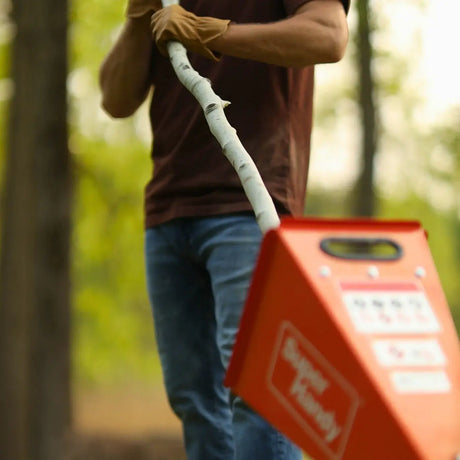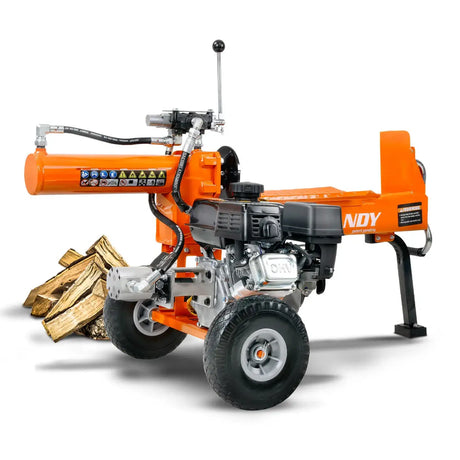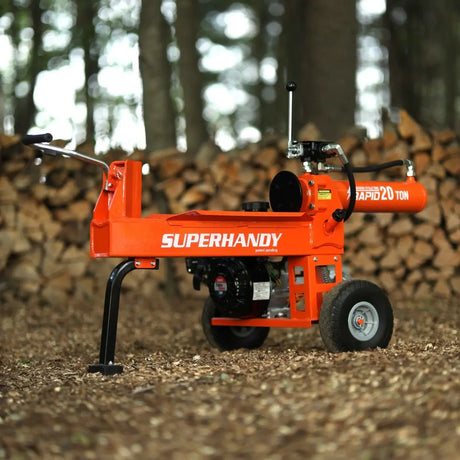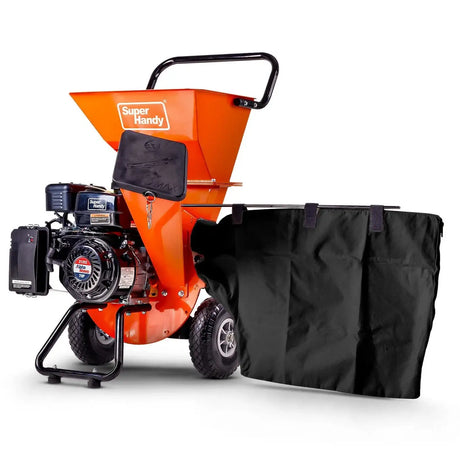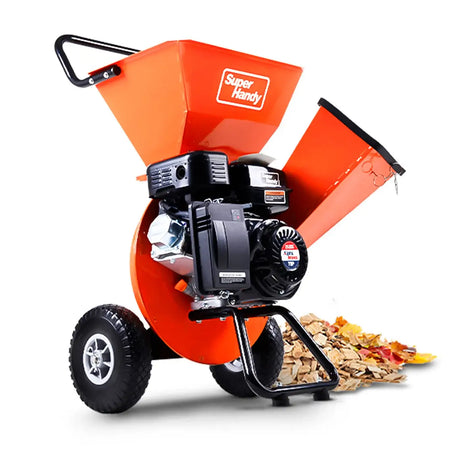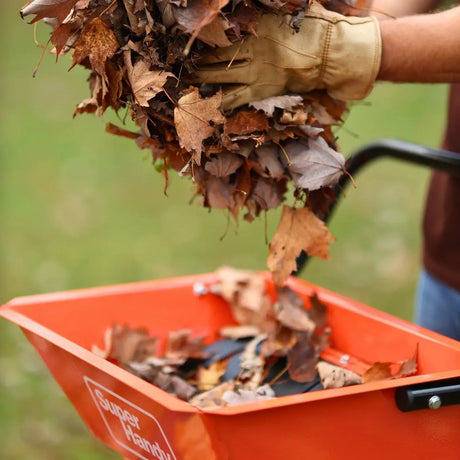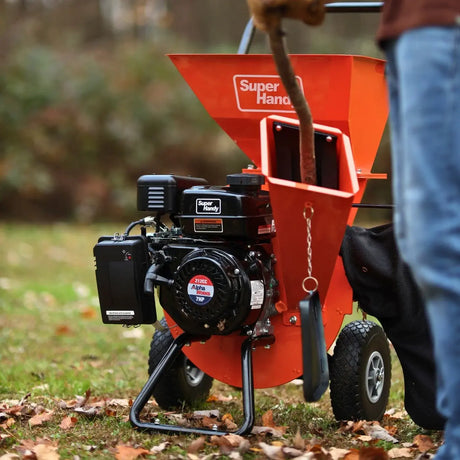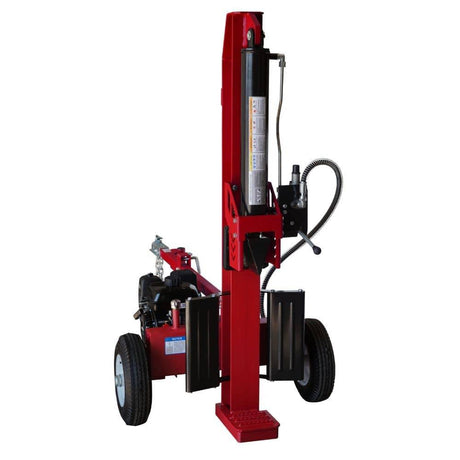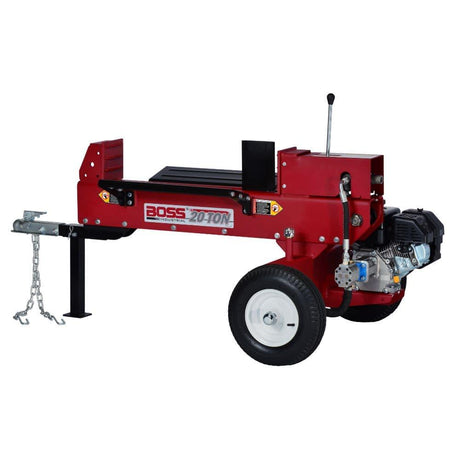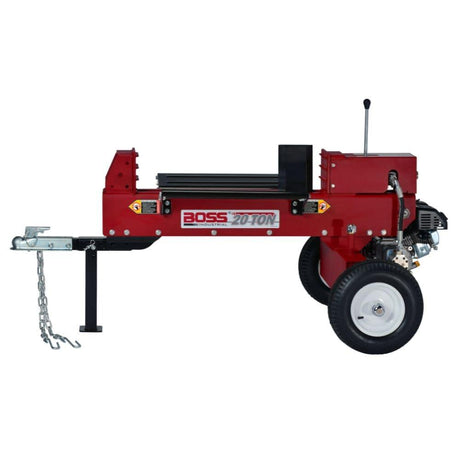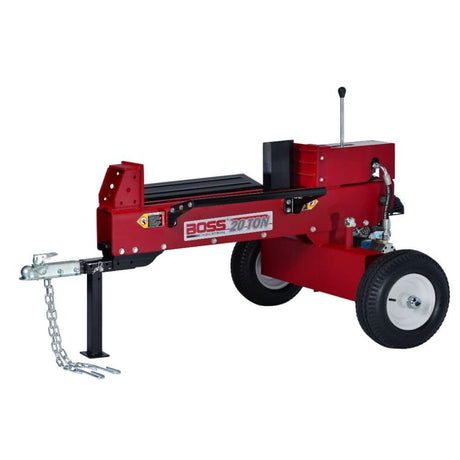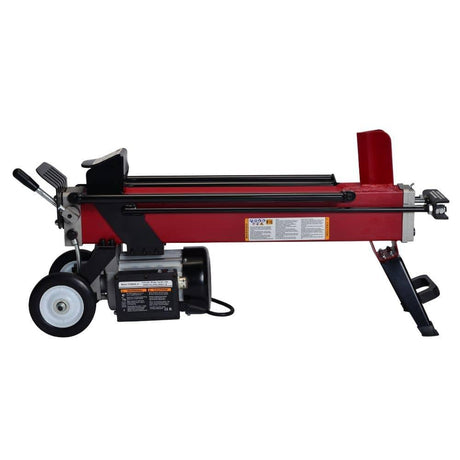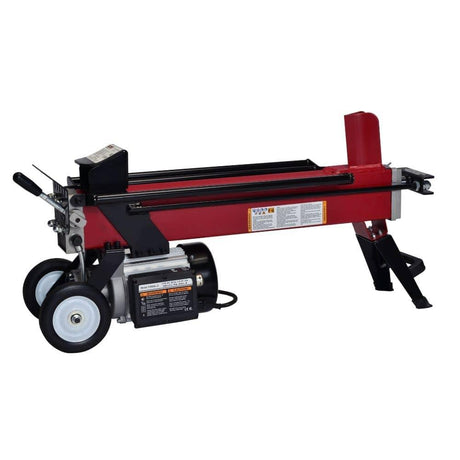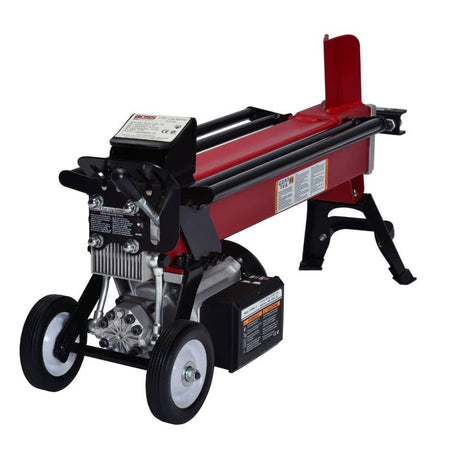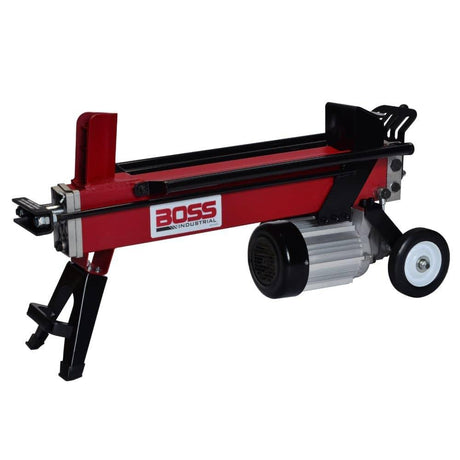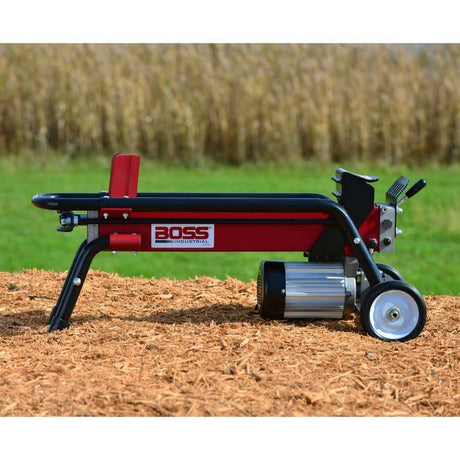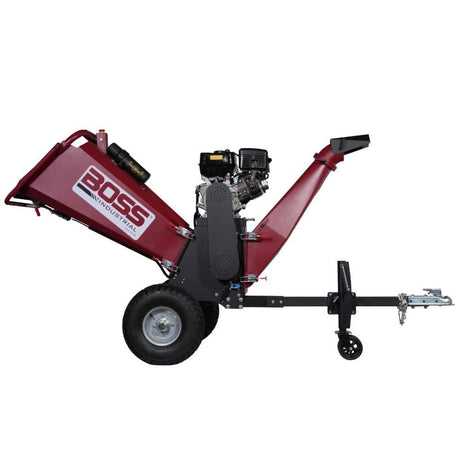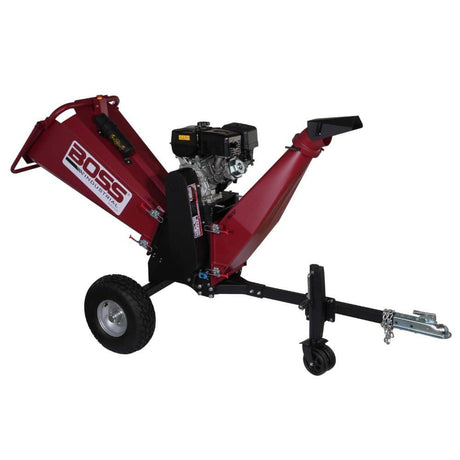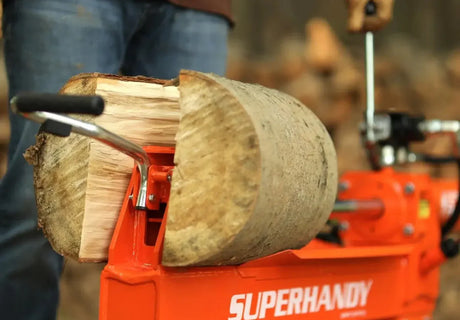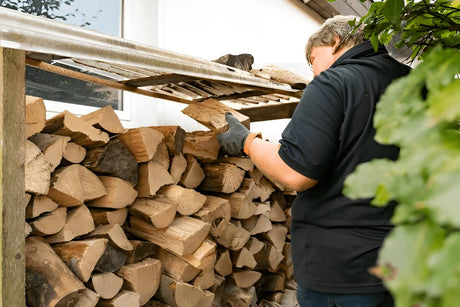Why Log Splitter Maintenance Matters
If you want your log splitter to last for years and run like a champ every season, maintenance isn't optional-it's essential.
For a complete step-by-step breakdown of maintenance tasks by hours of use, check out our maintenance checklist by hours of use.
Extend Lifespan and Maximize Performance
Think of your log splitter like a truck-it'll run for decades if you take care of it, or die young if you don't.
- Clean oil and proper lubrication keep the internal parts from grinding themselves down.
- A sharp wedge slices wood faster and puts less stress on the ram.
- Well-maintained hydraulics (or flywheels, for kinetic models) mean full power every time you engage the controls.
Prevent Breakdowns and Costly Repairs
Most log splitter problems don't come out of nowhere-they build up slowly from neglect.
- Low or dirty hydraulic fluid can overheat and destroy your pump.
- Worn belts on kinetic models can slip, snap, or jam up the flywheel.
- Ignoring small leaks or loose fittings often leads to full-blown pressure loss mid-job.
When and How Often Should You Maintain It?
It depends on how much you use it-but here's a general rule of thumb:
- Before each use: Check fluids, hoses, and moving log splitter parts.
- Every 10-20 hours of use: Top off oil, inspect filters, clean the ram and wedge.
- Seasonally or annually: Full fluid change, blade sharpening, replace any worn seals or belts.
If you're splitting all year or commercially, tighten that schedule. Just like sharpening a chainsaw, a little routine care keeps your machine-and your workflow-running smooth.
For a detailed maintenance schedule by hours of use, see our maintenance checklist by hours of use.

Before You Start: Safety First
Before you grab a wrench or pop open the reservoir cap, let's cover the basics. Maintenance is hands-on work-and with high-pressure hydraulics or spinning flywheels, it's not something to take lightly.
Still unsure if your machine is the right size for your workload? Check out our guide on log splitter sizing before investing in major repairs.
Must-Have Protective Gear (Gloves, Goggles, Boots)
Working on a log splitter means dealing with sharp edges, hydraulic fluid, and heavy parts. Don't skip the gear.
- Gloves: Not just for grip-good gloves protect you from hot surfaces, pinched fingers, dangerous fluids and unexpected leaks.
- Safety glasses or goggles: Hydraulic oil under pressure can spray. If a hose leaks or bursts while you're checking it, you'll be glad you wore eye protection.
- Steel-toe boots: Dropped logs and wedges aren't forgiving. Keep your feet covered.
It's basic gear-but it's the difference between a clean job and an ER visit.
Power Down, Cool Down: Prep the Log Splitter for Inspection
Never work on a log splitter while it's running or pressurized. Always shut it down properly:
- Turn off the engine or unplug electric models.
- Let it cool for 15-30 minutes before touching engine parts or hydraulic lines.
- Relieve system pressure by opening the bleed valve or working the control lever after shutdown.
Hydraulic systems can stay pressurized even when the machine is off. Don't assume it's safe until you've released that pressure.
For more safety tips while operating your machine, check out our step-by-step guide on how to use a log splitter safely.
Safe Work Area Setup (Flat, Clean, Dry Ground)
Before you even grab your tools, check your surroundings.
- Level surface: You don't want the log splitter tipping mid-repair or rolling unexpectedly.
- Dry ground: Fluids spill. Dry footing helps prevent slips and gives you better control of tools.
- Clear the clutter: No kids, pets, or tripping hazards nearby. You need full focus.
A clean, stable work area saves time and could prevent an injury. And If you have the user manual for your log splitter, look for repair and maintenance instructions.

Step-by-Step Log Splitter Maintenance Checklist
Keeping your log splitter in peak condition doesn't have to be complicated. Whether you're splitting every weekend or just stocking up for winter, these maintenance steps will keep things running smooth and safe.
| Maintenance Task | Before Every Use | Weekly | Monthly | Seasonally | Annually |
|---|---|---|---|---|---|
| Check hydraulic fluid | ✅ | ||||
| Inspect hoses for leaks | ✅ | ✅ | |||
| Clean debris from beam/wedge | ✅ | ✅ | |||
| Sharpen or inspect wedge | ✅ | ✅ | |||
| Change engine oil (gas models) | ✅ | ✅ | |||
| Replace air filter | ✅ | ✅ | |||
| Drain fuel before storage | ✅ |
Daily / Pre-Use Checks
Before each use, take five minutes to scan your machine. These quick checks help catch small issues before they turn into major downtime.
Check Hydraulic Fluid Level and Leaks
- Pop the cap on your fluid reservoir and make sure it's about ¾ full-not overfilled.
- Look underneath the log splitter and around the cylinder for drips or wet spots.
Tip: Lay a piece of cardboard under the log splitter overnight-if you spot wet circles in the morning, you've got a slow leak somewhere.
Inspect Hoses, Fittings, and Clamps
- Run your hand (carefully) along hoses to feel for cracks, bulges, or dry rot.
- Wiggle hose clamps and fittings to make sure nothing's loose.
- If any fitting oozes fluid or weeps after use, it might just need a gentle tighten-or a full replacement.
Clean Debris from Beam, Ram, and Wedge
- Wood chips, bark, and sap buildup can gum up your ram or misalign the wedge.
- Wipe down metal contact points after each session with a dry cloth or compressed air.
- Keep an old paint scraper handy for stuck-on gunk.
Weekly / Monthly Maintenance
If you're splitting regularly, set aside a little time every few weeks to go deeper.
Change or Top Off Hydraulic Fluid
- Check the operator's manual for the recommended fluid type-most use AW32 or AW46 hydraulic oil.
- Don't mix brands or types unless you've completely flushed the system.
Lubricate Moving Parts
- Apply light grease to the beam where the ram slides, especially if you hear squeaking.
- Add a few drops of oil to pivot points on control levers and linkages.
- Avoid over-greasing-too much traps dirt and dust.
Inspect Tires and Axle if Towable
- Look for cracks or dry rot on the sidewalls.
- Check the axle bolts, cotter pins, and hubs for tightness.
- Don't forget the safety chains and hitch latch if you trailer your unit between jobs.
Seasonal or Heavy-Use Maintenance
At the end of the season-or more often if you're splitting commercial volume-do a full tune-up.
Replace Hydraulic Filters
- Clogged filters slow your ram and strain the pump.
- If the ram feels sluggish or jerky, a dirty filter is often the culprit.
- Always replace with a filter rated for high-pressure hydraulic systems, not automotive types.
Sharpen or Reshape the Wedge Blade
- A dull wedge splits slower and puts more load on the hydraulics.
- Use a coarse metal file to re-shape chipped edges, then finish with a finer file.
Check Engine Oil, Spark Plug (Gas Models)
- Drain and replace oil according to your instruction manual-10W-30 is common, but always check.
- Clean or swap out the air filter if it's dusty.
- Remove the spark plug, clean carbon buildup, or replace if it's fouled.
Pro tip: Keep a mini logbook of service dates-it makes troubleshooting easier down the line.

Hydraulic Log Splitter Maintenance Tips
If your Hydraulic log splitter runs on hydraulics, keeping the system clean and pressurized is everything. Here's how to keep it in top shape.
Best Hydraulic Oil for Log Splitters
Not all hydraulic fluids are created equal. Choosing the right one keeps your hydraulic log splitter running cooler, smoother, and longer.
- AW32 hydraulic oil is ideal for colder climates or winter use. It flows easily in lower temps and helps avoid sluggish starts.
- AW46 is better for warmer environments-it offers an extra protection under high heat and heavy loads.
Before you top off or change the oil:
To pick the right hydraulic fluid, check out our hydraulic fluid guide for homeowners and pros.
- Always check your owner's manual. Some machines are picky, and mixing types can cause foaming or reduced pressure.
- If you're switching types, flush the system first-don't mix AW32 and AW46.
How to Remove Air from the Hydraulic Cylinder
Air in the hydraulic system = noticeably less power or jumpy ram. You might notice hesitation, noise, or slower splits. Bleeding the air is quick and easy.
Here's how:
- With the cap loose, start the log splitter and run it with no wood.
- Fully extend and retract the ram 4-5 times.
- This process pushes trapped air back to the reservoir.
- Once done, tighten the filler cap and you're good to go.
Do this after every full fluid change, or anytime your hydraulic log splitter's been tipped during transport.
Signs of Hydraulic Problems (Slow Ram, No Pressure)
Catch early signs before your log splitter grinds to a halt. Common hydraulic red flags include:
- Ram moves slowly or stalls under load → Usually low or contaminated fluid, or a clogged filter.
- No pressure at all / ram doesn't move → Could be a failed pump, broken seal, or an airlock in the system.
- Chattering, whining, or jerky movement → Often means air in the system or cavitation due to low fluid.
- Hydraulic fluid leaks or foamy reservoir → Damaged hoses, loose fittings, or mixing fluid types can cause this.
If you're seeing any of these issues, start with the basics:
- Check your fluid level.
- Replace the filter.
- Bleed the system.
- Inspect hoses for cracks or wear.
Shop Hydraulic Log Splitters →

Kinetic Log Splitter Maintenance: What's Different?
If you're using a kinetic log splitter, you're working with speed and simplicity. No hydraulic oil to mess with, no hydraulic fluid leaks to worry about-but that doesn't mean it's maintenance-free. These machines rely on high-speed parts like flywheels, gears, and belts, and if one of them gets out of sync, you'll feel it right away.
No Hydraulic Fluid? Here's What You Still Need to Watch
Kinetic splitters skip the whole hydraulic system, which is great if you hate dealing with oil changes and pressure bleeds. But there are still a few things you do need to keep an eye on:
- Debris buildup inside the housing or under the deck.
- Dust and fine wood chips around the moving parts-especially near the rack-and-pinion or gear track.
- Loose hardware from all that vibration during operation.
Flywheel & Gear System: Keep It Clean and Aligned
The flywheel is your muscle-it stores energy and releases it in a fast punch. But if it gets dirty, misaligned, or chipped, performance tanks.
Here's how to stay ahead of problems:
- Clean around the flywheel area with compressed air or a brush every few uses.
- Check for metal shavings or wear on gear teeth.
- If it starts making odd noises or feels off-balance, stop using it and open the housing. Misalignment can damage the entire drive system.
Tip: If you've hit a particularly tough knot and the ram slammed hard, give it a quick inspection afterward-just to be safe.
Belt Tension and Wear: When to Adjust or Replace
The belt is what connects the flywheel system to the ram. Over time, it'll stretch or crack-especially in hot, dry climates or with heavy use.
Look for:
- Slipping or squealing sounds during operation
- Cracks or glazing on the belt surface
- Soft spots that flex too easily
Adjust tension according to the manual (usually with a small turn of a bolt or nut), and replace belts every 1-2 seasons depending on usage. Always use the correct size-too tight, and you'll burn out the bearings. Too loose, and it won't fire properly.
Common Issues with Kinetic Splitters (and Easy Fixes)
These splitters are fast, but they don't love abuse. Here are the top problems I see:
- Ram won't retract → Check for debris blocking the return spring or track.
- Weak strikes or half-splits → Usually a loose or worn belt. Adjust tension first.
- Gears grinding or locking up → Clean and realign flywheel teeth; grease the track lightly if allowed.
- Sudden stops or jerky motion → Could be a cracked pinion or out-of-balance flywheel-shut it down and inspect closely.
Maintenance Schedule for Kinetic Units
Here's a simple guide that keeps you on track:
After each use:
- Wipe down the housing and controls
- Check the belt for visible wear
- Clear debris from the track/flywheel area
Every 10-15 hours:
- Inspect belt tension and adjust if needed
- Brush or air-blow the gear teeth
- Check all bolts and hardware
Every season (or 40-50 hours):
- Replace the belt if worn or stretched
- Inspect the flywheel, gear track, and bearings
- Clean under panels and guards thoroughly
Kinetic splitters are built for speed, but speed only helps if your machine's dialed in. Keep it clean, keep it aligned, and it'll rip through logs like butter.

Log Splitter Storage Tips
Done splitting for the season? Before you push your log splitter into the corner of the shed-or worse, leave it out in the yard-take a few minutes to store it the right way. A little prep now saves you from rust, leaks, or startup headaches later.
How to Store Your Splitter for the Off-Season
Whether it's gas, electric, hydraulic, or kinetic, every log splitter benefits from a quick end-of-season routine.
Here's what I recommend:
1. Clean it top to bottom.
- Knock off bark, chips, and dried sap.
- Wipe down the beam, wedge, and controls with a dry rag.
- Use compressed air to clear dust from motor vents or kinetic housings.
2. Drain or stabilize fuel (gas models).
- Run the tank dry, or add a fuel stabilizer and run it for 5 minutes.
- Old fuel = gummed carbs and no-start frustration.
3. Check and top off fluids.
- Hydraulic oil should be clean and at the right level.
- Don't store it low-it can draw in air or moisture over time.
4. Grease any exposed metal.
- A light coat on the wedge and ram prevents rust while it sits.
- Avoid getting grease on belts or moving control levers.
Indoor vs. Outdoor Storage (and How to Cover It)
Best-case scenario? Store it indoors. A garage, shed, or barn keeps it out of the rain and away from temperature swings.
If you must leave it outside:
1. Raise it off the ground using blocks or wood runners. Moisture rises-don't let it sit in the mud.
2. Use a waterproof, breathable cover.
- Don't wrap it in a tarp and forget it-that traps moisture.
- Look for vented equipment covers that fit snug and shed water.
What to Do Before Long-Term Storage
If you're putting it away for a few months (or longer), go a step further:
- Disconnect the battery (electric start models) or remove it entirely and trickle charge it indoors.
- Tilt the machine slightly forward to allow any residual water to drain out.
- Label anything you noticed during the season (weak belts, sticky levers, etc.) so you know what to tackle first come spring.
- Cover the exhaust port with a rag or screen to keep bugs or mice from crawling in.
Common Log Splitter Maintenance Mistakes to Avoid
Even experienced users slip up sometimes. And when it comes to maintenance, small oversights can turn into big repairs. Let's walk through the most common mistakes I see - and how you can steer clear of them.
Overfilling the Hydraulic Reservoir
It might seem harmless to top it off "just in case," but overfilling your hydraulic tank can cause real issues.
- Excess fluid expands as it heats up, and if there's no room to breathe, pressure builds.
- That pressure forces hydraulic oil out through seals and caps, which leads to messy leaks or even blown gaskets.
- Too much fluid can also cause foaming, which weakens system pressure and slows down your ram.
Reminder: Always check with the ram fully retracted-don't guess.
Ignoring Fluid Contamination or Dirty Filters
Your hydraulic fluid is the lifeblood of the system. When it gets dirty, gritty, or milky (from water contamination), it's only a matter of time before parts wear down.
- Contaminated fluid leads to sticky valves, slow ram movement, and excessive wear on your pump.
- Clogged filters make your pump work harder, which strains the engine or motor and shortens its life.
Watch for signs like:
- Jerky ram motion
- Slow splitting speed
- Loud whining sounds under load
What to do:
- Change hydraulic filters once per season (or sooner with heavy use).
- Replace the fluid entirely every 100 hours or every 1-2 seasons.
- Always use clean funnels and sealed jugs when adding new fluid.
Using the Wrong Lubricants or Tools
Not all grease is the same. Not all fluids play nice together. Using the wrong stuff can break seals, corrode fittings, or reduce performance across the board.
Biggest offenders I see:
- Using motor oil instead of hydraulic fluid
- Applying grease to areas that should stay dry, like drive belts
- Using WD-40 as a lubricant (it's a cleaner-not a long-term lube)
How to avoid it:
- Use lithium or moly-based grease on the ram rails and pivot points.
- Only use hydraulic fluid that meets your machine's specs (usually AW32 or AW46).
- Don't guess-double-check your manual or ask someone who knows.

Final Thoughts: A Well-Maintained Splitter Is a Reliable Splitter
Taking care of your log splitter isn't just about avoiding breakdowns-it's about keeping the job smooth, safe, and stress-free every time you fire it up. Whether you split once a month or every weekend, proper maintenance pays off big in the long run.
Make It a Habit, Not a Hassle
Think of regular maintenance like seasoning cast iron or sharpening a chainsaw. A few minutes before and after use saves hours later.
Here's what makes it manageable:
- Keep your tools nearby (funnel, rags, grease gun, filter wrench).
- Set a simple routine: check fluids, wipe it down, inspect key log splitter parts.
- Tie it to the seasons-spring prep, fall shutdown.
Once it's part of your rhythm, you won't even think about it-you'll just do it.
Keep a Logbook for Service Intervals and Repairs
You don't need a fancy system-a notepad in your shed or a note in your phone will do. Just track:
- Date of oil and filter changes
- Belt replacements or hydraulic top-offs
- Any issues (slow ram, leaks, weird noises) and what you did to fix them
It helps you spot patterns, plan ahead, and boost resale value if you ever sell.
When to Call in a Pro for Service
Most maintenance is DIY-friendly-but don't be afraid to call in backup if you hit one of these:
- Persistent hydraulic leaks (especially near the pump or valve)
- Ram won't extend or retract, even after fluid/filter checks
- Flywheel or gear noise from a kinetic splitter you can't identify
- Engine issues on gas models (stalling, won't start, heavy smoke)
Sometimes, paying for a proper diagnosis saves you hundreds in parts-swapping and downtime.
At the end of the day, a properly maintained splitter rewards you with faster work, cleaner splits, and a machine you can count on-season after season.


